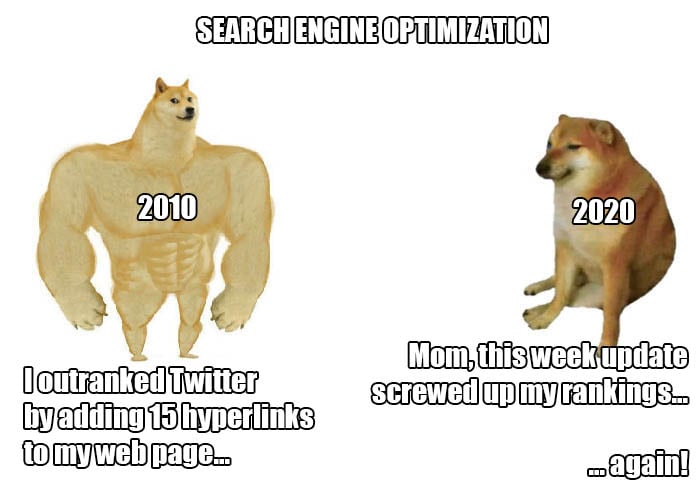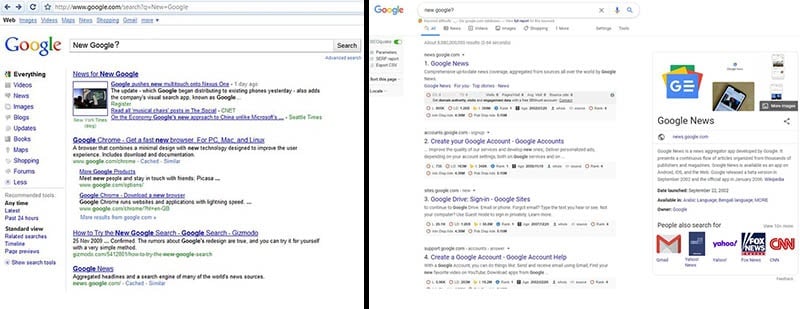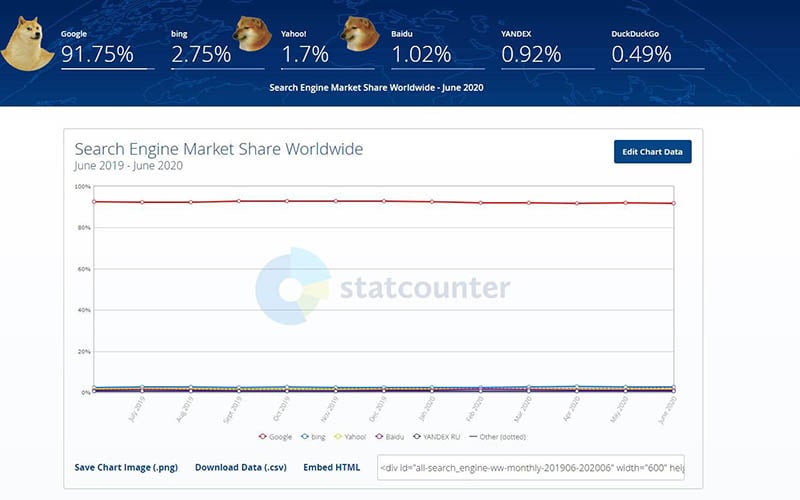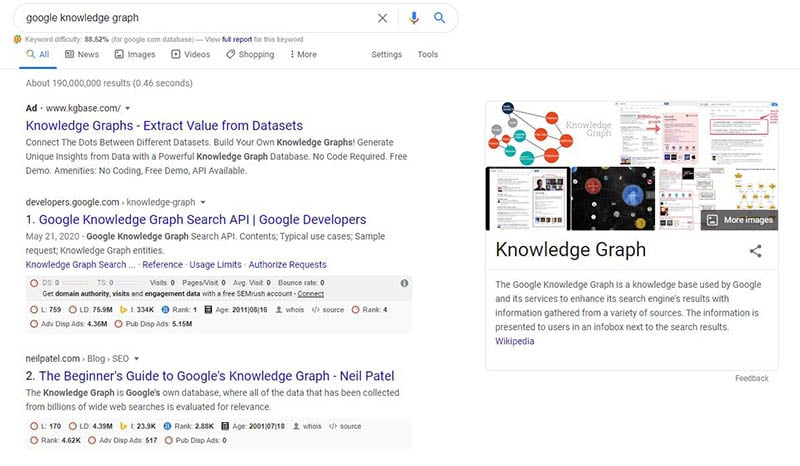WEBITMD goes retro! Today we bring to you a comparison of how SEO was in 2010 vs. how we know it today. The choice of topic is not random: SEO has been one of the most growing aspects of digital marketing in 2020, given the situation derived from the Coronavirus. But we’re not boring you with how stay-at-home and some other measures that changed the game in marketing (not today, at least).
Instead, we want to analyze the changes in SEO as a technique but even more, in the ways people used to navigate the internet; which by the way generated many of those changes in SEO in time.
Also, who were the big players back then? Was Google the almighty giant it is now? What are those aspects that we take for granted in 2020 that were the total vanguard 10 years ago? All this and more in this original Throwback Thursday article by WEBITMD.
SEO in 2010 Was Easier
Search Engine Optimization was never an easy game but for those who are in it since the very beginning, the difference in how it was merely 10 years ago is massive.
There are some specific reasons for that:
- There were not that many rules for SEO: Back in 2010, your website could reach the first page of Google by merely using keywords, disregarding the quality of the content. Nobody was concerned about keyword stuffing, or they didn’t even take it into consideration.
- There were not that many changes in Google Algorithms: Or better said, they were not that frequent; so the impact in SEO was not that big or unpredictable. For this reason, people both in the digital marketing industry and business owners alike wouldn’t freak out the way they tend to do now when Google announces an update.
- There were not that many competitors: As for December 2010, there were 255 million websites worldwide; compared to 1.74 billion (and counting) in 2020. This means your website had way less competition. You could rank first or second for a certain keyword and then see the other results on the first page of Google vaguely relate to that query. Now, many high volume keywords (and first places) are practically monopolized by Yelp or Angie’s List no matter how properly optimized or good your content is.
- There were not that many (ethical) people doing SEO: Although everybody in the industry and business owners as well knew how important it was to rank on Google, SEO didn’t have that many practitioners. And as we pointed out some lines above, there were not that many rules. Unfortunately, that led to some of those ‘pros’ to fall into practices that were not so ethical and fair (what eventually was known as black-hat SEO), or not even deliver tangible results to their clients.
- There was more trust in SEO: Back then Search Engine Optimization was, in fact, more demanded than, let’s say, paid media. Unfortunately, the unethical behavior we pointed out before (and their consequences, like ranks plummeting, Google penalizations, etc.) led the whole SEO industry to burn out, as well as clients’ trust. Many business owners educated themselves not only out of necessity to rank but also, to avoid being scammed.
Just because it was ‘easier’, that doesn’t mean SEO in 2010 was necessarily better. As you can see, many of the practices that were usual back then are now considered unacceptable and even counterproductive. It was actually those fraudulent practices that practically forced the SEO game into the intricate, complex activity it is in 2020.
What Happened in the Following Years?
2010 was the kickstart of many changes that we mostly give for granted in 2020. It was in that year, for example, that Google introduced instant search; which predicts what you’re searching for when you start typing on the search bar.
The whole SERP as it is has suffered drastic changes. Google is definitely much better optimized, faster, and prioritizes quality content and positive reputation better than just pages with related search terms. In fact, it was also in 2010 that Google announced that site speed would be a (then new) ranking factor.
After page speed, mobile-first indexing would also be implemented. First, Google transformed itself into a mobile-first company in (guess what year?) 2010. In the following years between 2011 and 2014 mobile use would go in a continuing growth until 2015, the year in which Google announced that mobile searches surpassed desktop for the first time. A mobile-friendly algorithm followed that same year, and on July 1st, 2019 it was announced that it was enabled by default for all new websites.
One curious fact that maybe most of the users forgot is that back in 2010 Google didn’t necessarily have the ownership that it holds nowadays when it came to search engines. Bing and Yahoo were still powerful contenders! In an article from December 2009, MOZ predicted that 2010 would be the year of “a two-engine, 80/20 world”; which meant that both search engines would hold 20% of the search engine market share in the following year.
Coming back to 2020, here are the shares, according to Statcounter:
The (Not So) Good ‘Ol Days; And How SEO Was Made Great Again
How many times have you read “content is king”? Aside from being a truth we all (kinda) agree with, it actually took a while to naturalize it. Before the implementation of Panda in 2011, a great part of the SEO game consisted of what we now know as keyword stuffing and spammy content. Many of the dos and don’ts in SEO that we all know now were not that clear back then.
These rules were mostly set by the many Google algorithm updates that came up between 2010 and 2020. Here’s a list of some of the main ones:
2010
Google Places: originally rolled out in September of 2009 as part of Google Maps, it integrated places pages to match with local search results better.
Caffeine: also rolled out in 2009, it aimed to boost Google’s speed and integrate crawling and indexation. It had a big positive impact on Google’s index.
Instant Previews: it started Google’s trend to predict users’ needs by suggesting search results as you typed your query.
2011
Panda/Farmer: a major algorithm update targeting quality issues like poor content, sites with high ad-to-content ratios, content farms, and others. It would have several updates itself in 2011 and in the following years.
Schema.org: a joint effort with Yahoo and Bing to make search listings richer.
Google +: launched to compete with Facebook, it reached the 20 million users within the 2 weeks of its release. It shut down for good in April 2019.
2012
Penguin: it set a new list of spam factors; including one we all know well – keyword stuffing.
DMCA Penalty: Google started penalizing websites that received too many DMCA takedown requests. A big hit on duplicated content on the internet.
Knowledge Graph: the now typical image results that appear on Google Search whenever we make a query. It was Google’s effort to take semantic search a step forward by providing more than links as query answers.
2013
Hummingbird: more of an update or an add-on, this was an overhaul of the core algorithm. It aimed to change semantic search and the Knowledge Graph.
2014
Pigeon: it targeted local listings in a search, and created closer ties between the local algorithm and core algorithm(s).
HTTPS/SSL: this was the update that started Google preference over SSL encrypted sites. By 2018, websites without them started to be labeled as ‘unsafe’.
2015
Mobile Update or “Mobilegeddon”: the beginning of ‘mobile-first’! It was one of the rare cases in which Google pre-announced an algorithm update.
RankBrain: it revealed the use of machine learning by Google to process searches and provide more relevant results. Google also announced RankBrain as the third most important ranking.factor.
2016
Possum: named ‘the biggest change to Google’s local search ranking algorithm since 2014’, it decided which businesses should appear in a local search result.
2017
Intrusive Interstitial Penalty: do you miss pop-ups and other aggressive interstitials? Google started punishing them in this update; especially those that affected mobile experience.
Google Jobs: Google’s job portal drawing data from LinkedIn, Monster, Glassdoor, and other major providers.
2018
Mobile-First Index Roll-out: although Google had been prioritizing mobile-friendly sites since 2015, this update officially set responsiveness as one of the major ranking factors.
“Medic” Core Update: although it focused mostly on medical and healthcare sites, it generated a large-scale impact. This update intended to improve search results’ accuracy by listing them according to users’ intent.
2019
March’s Core Update: announced as ‘the third major core update’, it continued 2018’s ‘medic’ aim to medical and YMYL websites.
BERT Update: it helps Google better interpret natural language searches and to understand context.
2020 (so far…)
January 2020 Core Update: linked to the three previous core updates, it was basically an extension of them rather than improving some specific aspects.
WEBITMD Was There!
Ever since the beginning, WEBITMD strived to be right there where things were happening. That’s why we always tried to do something different from what we saw most of the digital marketing agencies were doing. We were there when many of the changes in SEO were taking place, and we’ve seen first hand the use of SEO techniques to improve client rankings; both ethical and not so. In any case, we’ve set a clear path on what we want and what we don’t want to be as a Digital Marketing and SEO agency.
We hope you enjoyed this Throwback Thursday blog and found it useful or, at least, curious! We also invite you to download our FREE SEO guide with useful strategies for your business, as well as WEBITMD’s personalized approach to search engine optimization:










.jpg)



.jpg)





![5 Reports to Elevate Your HubSpot Sales Dashboard [+ Examples]](https://blog.webitmd.com/hs-fs/hubfs/Imported_Blog_Media/6-winning-examples-of-a-hubspot-sales-dashboard-2.png?width=767&name=6-winning-examples-of-a-hubspot-sales-dashboard-2.png)